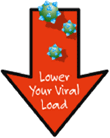Does
Nevirapine Lower Viral Load More than Efavirenz?
By
Liz Highleyman
 All
widely used antiretroviral
therapy (ART) regimens reduce plasma HIV RNA levels to
a so-called "undetectable" level in most patients,
typically defined as below 50 copies/mL. But ultra-sensitive
viral load tests show that almost all HIV positive people
have a low level of residual virus despite treatment.
All
widely used antiretroviral
therapy (ART) regimens reduce plasma HIV RNA levels to
a so-called "undetectable" level in most patients,
typically defined as below 50 copies/mL. But ultra-sensitive
viral load tests show that almost all HIV positive people
have a low level of residual virus despite treatment.
S.
Haim-Boukobza and colleagues from France performed a retrospective
analysis to compare levels of residual HIV viremia below 50
copies/mL among patients receiving the NNRTIs nevirapine or
efavirenz, both in combination with a NRTI backbone of tenofovir
(Viread) plus emtricitabine
(Emtriva).
The
study included 165 HIV positive participants observed after
they had achieved and maintained virological suppression (<
50 copies/mL) for at least 6 months using standard tests.
A total of 75 were using nevirapine and 90 were taking efavirenz.
The
researchers measured residual plasma viral load using an ultra-sensitive
assay with a limit of quantification of 1 copy/mL. They then
compared the proportions of patients in the nevirapine and
efavirenz groups who suppressed HIV RNA below this level.
Results
 |
Participants in the nevirapine group had a viral load
below 1 copy/mL significantly more often than people in
the efavirenz group (81.3 vs 55.6%, respectively; P <
0.001). |
 |
In
a multivariate analysis controlling for potential confounding
factors, the only factors independently associated with
viral suppression below 1 copy/mL were: |
| |
 |
Using
nevirapine rather than efavirenz: odds ratio (OR)
2.85 (P = 0.005); |
 |
Duration
of viral suppression on ART: OR 2.07 (P = 0.005). |
|
To
explain these findings, the study authors noted that nevirapine
has good penetration into anatomic "compartments"
that can serve as viral reservoirs, such as the brain and
genital tract. Controlling HIV in these compartments may prevent
the virus from escaping and starting to replicate in the blood.
However, the investigators cautioned that the clinical relevance
of having a viral load below 1 copy/mL is unclear. Further
research is needed to determine, for example, how low-level
residual virus affects systemic immune activation and inflammation,
which have been linked to premature immune system aging and
increased risk of non-AIDS conditions such as cardiovascular
disease.
Investigator affiliations: Laboratoire de Virologie, AP-HP,
Groupe Hospitalier Pitié-Salpêtrière,
UPMC Univ Paris, France; Laboratoire de Virologie, AP-HP,
CHU Saint Antoine, France; UPMC Univ Paris, France; Service
de Maladies Infectieuses, AP-HP, Hopital Saint-Antoine, France;
Boehringer Ingelheim, France; Service de Médecine Interne,
AP-HP, Groupe Hospitalier Pitié-Salpetrière,
Paris, France; Service de Maladies Infectieuses, AP-HP, Groupe
Hospitalier Pitié-Salpêtrière, Paris,
France; UPMC Univ Paris, INSERM U943, Paris, France.
1/7/11
Reference
S
Haim-Boukobza, L Morand-Joubert, P Flandre, and others. Higher
efficacy of nevirapine than efavirenz to achieve HIV-1 plasma
viral load below 1 copy/ml. AIDS (Abstract).
December 13, 2010 (Epub ahead of print).
